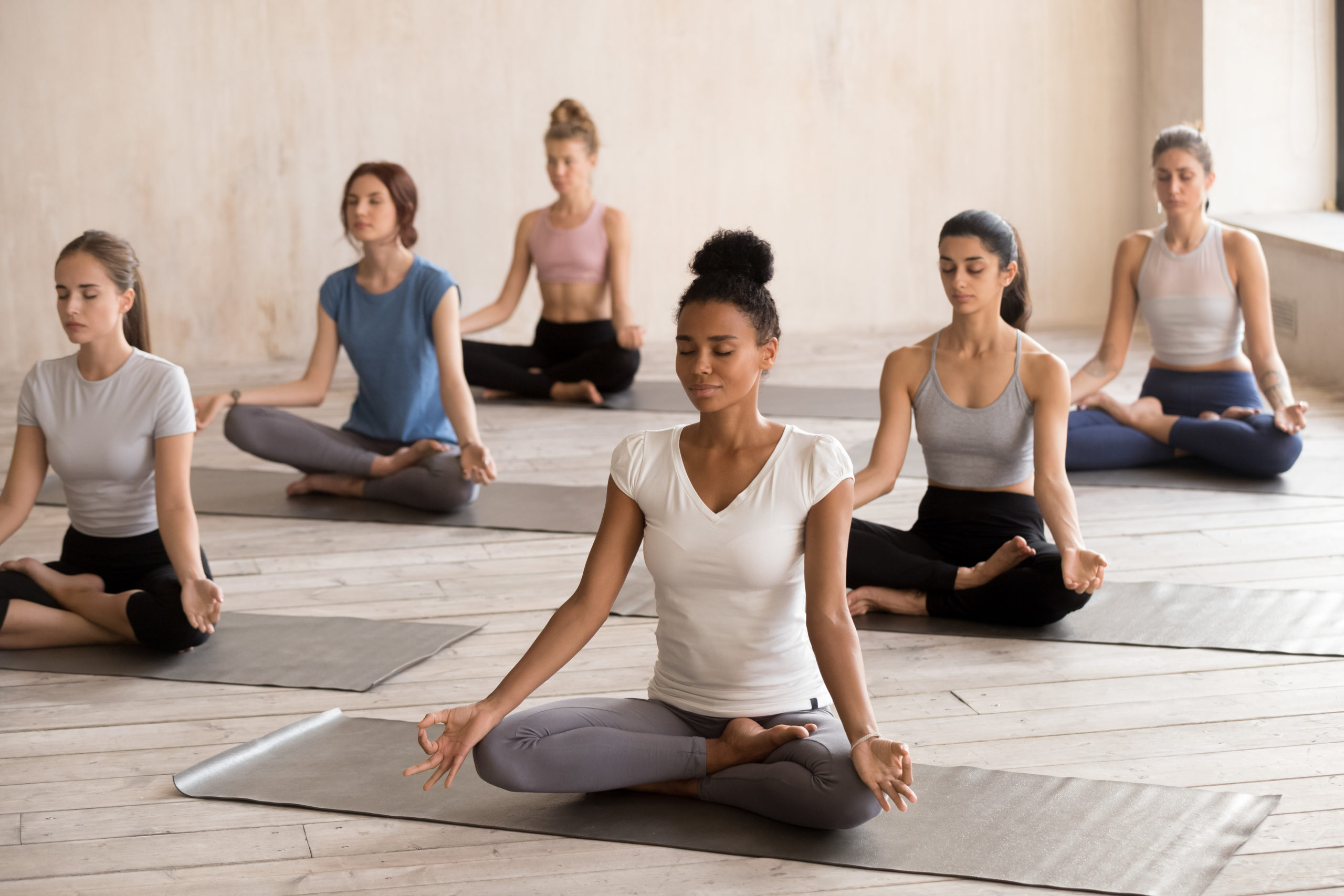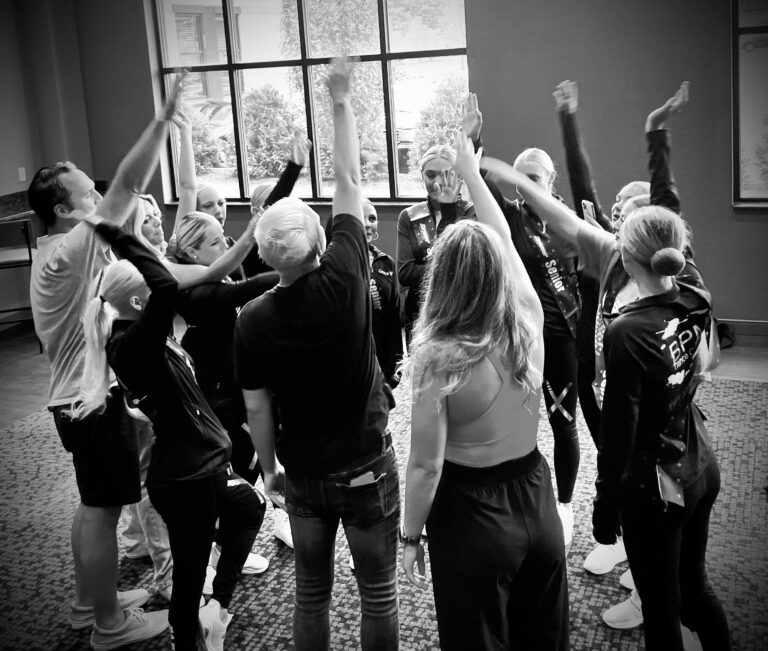
Meditation is a tool that trains attention and awareness, improving mental clarity and ultimately helping dancers (and teachers!) get out of their heads and into the moment. But doing meditation right goes way beyond the typical sitting and chanting.
Though an “om” every now and then doesn’t hurt, there are numerous other ways to tap into a meditative state, dance itself being one of them. In fact, many of the activities we see in the studio—like visualization exercises, breathing techniques and improv sessions—more than likely resonate because they naturally pull us into a calmer mental state.
But dance teachers can also incorporate meditation into class intentionally. Dance Teacher spoke to four educators to learn how they’ve done it, and the benefits they’ve seen for themselves and their students.
Andrew Wilson
Andrew Wilson is a theater dance, jazz and acro teacher known for his roles in musical theater pieces like the first national tour and Disney+ Live Capture Event of Newsies: The Musical and the Broadway revival of Cats. In his early days of training in NYC, he noticed a hierarchy in the studio that often led to thoughts of comparison and self-judgment. Now, in his classes, he focuses on acknowledging those self-doubts through meditative storytelling.
The meditation exercise that embodies a judgment-free zone
“If you’re feeling judgment creep in, a meditative exercise that I like to do is hand out paper and some markers. With the paper on the floor in front of us, we close our eyes and let our arm do a dance as I say a few words or themes that are usually centered around love or achievement. We open our eyes and look at these masterpieces, and then tape them around the mirror. Anytime we have a moment of self-judgment, we can just refocus back on our masterpiece and channel what it represents.”
Using meditation techniques for increased sensory awareness
“I often ask my students to close their eyes and begin to focus their awareness on each of their senses starting from the feet up. This allows them to feel the character throughout their entire body. If we’re doing the musical Newsies, it’s based in 1899. So, I might start by asking what their feet feel like walking on the cobblestone. What does the temperature feel like in this era? What does it smell like? Questions that help them more easily visualize themselves in the reality of the scene. When we open our eyes, I hope they no longer see four walls around them, but the streets of New York City in vivid detail. Evoking environment through meditation helps to create spatial awareness through the senses.”
Ms. Vee
A longtime Broadway Dance Center favorite, Ms. Vee is known for her challenging hip-hop, popping, locking and house classes. She introduced meditation into her hip-hop teaching as an opposing extreme, to create a moment of relaxation and recalibration.
On the importance of meditation in dance spaces
“As dancers, it’s our job to move. So, in order to create balance, we have to find space for stillness so that we can feel that opposite end of the spectrum.”
Her meditative wind-down
“During the last 10 minutes of class, I lead the students into a final mini meditation. We start in a child’s pose and I take them into a savasana. I guide them through this head-to-toe releasing of the body and surrendering their bodies into the floor. Then I play ‘Pretty Wings,’ by Maxwell, and I instruct them to breathe and really feel their breath for one minute.

“We go into a few last stretches, and before we stand up, we do a forward fold hang where I lead them through a big release of their heads, necks, faces, teeth and tongues. Then, we finally roll up and do a little grooving before we end with some water.”
On the unexpected benefits of meditation
“Meditation helps dancers tap into their parasympathetic nervous system, making it easier for them to take on more information.”
Rashidi Omari
Rashidi Omari, director of the Destiny Arts Youth Performance Company in Oakland, California, is a dance educator known for blending a multitude of dance styles from hip hop and house to Lindy and dancehall. During his early days at Destiny, he was pleased to find that meditation took place before beginning a company meeting or rehearsal. Meditation had already been a positive part of Omari’s personal life and something he incorporated into his classes before coming to Destiny.
How he applies meditation in the classroom
“Usually I’ll do a quick check-in, which can be spoken or movement-based, or even a thumbs-up or thumbs-down, just to see where folks are. Or we’ll just go into a deep-breathing meditation. Sometimes it’s guided, other times I’ll offer a topic or an idea for them to think about while we mindfully breathe. Throughout the class, I’ll remind everyone to refocus on their breath. At the end, we’ll do some kind of check-out, similar to the beginning—or just freestyle.”
On opening students’ minds to possibilities beyond the studio
“Sometimes I’ll do a longer meditation where you visualize your body expanding, your energy expanding past your skin, filling the room, going out into the city, state and country; having them visualize their energy going all the way out into the universe and then coming all the way back.
“Some of the youth that I’ve taught haven’t been outside of their city, so having them thoughtfully imagine what it might look like to be outside of Oakland, or outside of California or the U.S., really opens their minds to all of the possibilities out there.”
On the significance of meditation during the pandemic
“The first couple of times meditating virtually were a little weird being in a room by myself. The key is allowing and acknowledging that this moment right here is for me to check in with me, regardless of all that’s happening around me.
“It’s important for us, especially during this time, to note where we are mentally, because everyone’s affected by this differently. As educators, artists, creators and activists, we always just keep pushing. And we may want to cry, but we might not notice that if we haven’t taken the time to ground and ask ourselves “How am I doing today?”
Jim Cooney
Jim Cooney is an award-winning director and choreographer, and founder of Amplified Artists. He is also a teacher who integrates meditation into his classes for artists and dancers, and was the faculty advisor of BDC’s elite Professional Semester training program (currently not running due to the pandemic). He realized that having dancers talk after class about what they’d like to improve on and how they’re going to do it resulted in massive growth for his mentees. This inspired the mindfulness techniques that he incorporates in his teaching today.
On the benefits of setting intentions in the classroom
“At the end of stretching, before we get up and actually start dancing, we just sit on the floor and set an intention. It could be anything you want to get out of taking the class. And people really feel like it gives them a sense of direction. A student actually recently told me that the reason why she became a regular was because of the meditation portion of class. Since musical theater is storytelling, coming to this neutral headspace before you take on a character and enter into the world of a show is a great practice.”
On the significance of meditation during the pandemic
“For me, meditation is like a calm body of water. Because that’s what it can bring to you: Equanimity and serenity. And COVID is like a tsunami wave. These tsunamis come all the time in life—in smaller or bigger waves—crashing into that surface. But meditative practices allow you to come back to that smooth surface much more quickly and easily.
“In this business, we often feel like we don’t have a lot of control. But meditation gives you that sense of authority over your own reality.”
His pre-class meditation
“I always have to take a few breaths to calm myself down and remind myself that I know what I’m doing before I step into a class. When I walk in, whatever energy I bring in is gonna set the tone for the class.”



